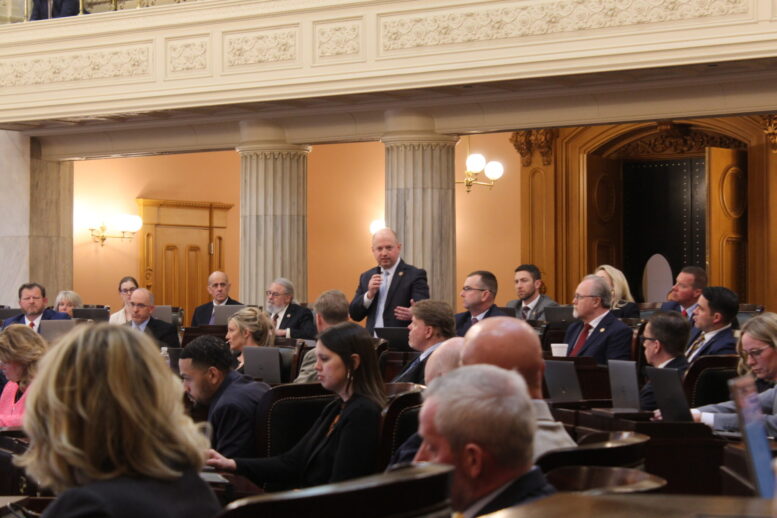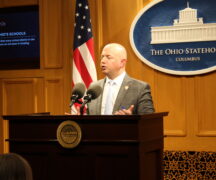BY NICK EVANS
The Ohio House advanced its two-year spending plan Wednesday despite sharp criticism from the chamber’s Democrats. The House’s version of the operating budget nixes several of the governor’s policy priorities and helps fund a new stadium for the Cleveland Browns.
The bill also walks back some of the House’s initial plans, but only slightly.
A proposal to force property tax reductions on the back of school district rainy day funds will allow administrators to carry over 30% of their budget instead of 25%. Budget drafters are scrapping a new population-based system for distributing library funding, but they’re not giving up on moving to a dollar figure appropriation instead of a percentage of the general revenue fund.
With Wednesday’s vote, the budget now moves to the state Senate, where lawmakers are sure to roll out on their own slate of changes. They’ll have time to mull it over as lawmakers leave for a two-week Easter recess.
The 2026 fiscal year begins on July 1; lawmakers have until then to finish off the budget.
Ohio House Finance Chairman, state Rep. Brian Stewart, R- Ashville, kicked off testimony, describing how the spending plan eliminates taxes from the governor’s proposal and spends $4.4 billion less in state money.
Those tax increases in governor’s proposal would’ve paid for a $1,000 child tax credit and a new fund for future stadium deals.
Instead, House Republicans favor a $600 million bond package in support of Cleveland’s proposed facility. “It is the most conservative stadium funding proposal in America,” Stewart insisted, arguing tax receipts from the project will pay back the debt. He went on to offer an amendment increasing from $38.5 million to $50 million a deposit paid by Brown’s ownership.
And that’s about where things went off the rails.
Rep. Sean Brennan, D-Parma, piped up with an amendment to Stewart’s eliminating the bond package entirely.
Rather than letting that Brennan proceed, House Speaker Matt Huffman ordered the chamber to stand at ease for several minutes. When session resumed, Huffman quickly called a vote despite Democratic lawmakers’ objections and points of order.
In the confusion, many Democrats didn’t wind up voting on the amendment at all. It passed 55-15.
Schools, property taxes, libraries and Medicaid
Many Democrats objected to a K-12 funding model that abandons the so-called fair school funding plan lawmakers have been working toward in the last two budget cycles. State Rep. Bride Rose Sweeney, D-Westlake, said that setting aside that formula returns to an ad hoc funding approach the Ohio Supreme Court ruled unconstitutional.
“This proposal is leading Ohio students and taxpayers back down a path of artificial guarantees, back to square one, back to residual funding, back to the days where school (funding) was based not on what it cost to educate a child, but what the General Assembly decides that it feels like paying for education.”
While school districts worry about how much funding is coming in, they could also have to consider how much is sitting on their balance sheet. The budget would direct county officials to pare back the property taxes which support schools if a district maintains a balance worth more than 30% of their annual budget.
“We are saying that government is not a piggy bank,” state Rep. David Thomas, R-Jefferson, argued, criticizing those carryovers as a poor return on taxpayers’ investment.
[RELATED: Child care funding changes in final Ohio House budget draft]
State Rep. Jack Daniels, R-New Franklin, defended the changes to library funding. He said “no agency is entitled to an increase,” and that making appropriations based on a percentage of the general revenue fund amounts to an “obligation.” And he complained the budget isn’t actually cutting dollars to libraries.
“They feel they’re being cut, when in fact, we are not cutting,” he said. “We’re just not providing the increase they expect.”
Notably, the Ohio Library Council determined the House proposal would appropriate at least $40 million less each year than the governor’s proposal.
Democrats also worry that the budget locks the state into radical changes to the Medicaid program if federal government makes even modest reductions to its 90% share of the program.
“If federal funding drops even slightly, say from 90% to 89% the entire program would be ended,” Rep. Rachel Baker, D-Cincinnati said. “That’s right, a 1% cut in federal funding would terminate the program that provides health care access to almost 800,000 Ohioans.”
Rep. Stewart downplayed the likelihood of federal changes, but argued the state expanded the program on the promise that the federal government would cover 90% of the program.
Rep. Jean Schmidt, R-Loveland, meanwhile praised the budget for “push(ing) back against the wokeness we are facing by prohibiting Medicaid funds from being used for discriminatory DEI programs and establishing a statewide policy recognize that there are only two sexes.”
Final tally
Rep. Dani Isaacsohn, D-Cincinnati said, “We are not the sexiest state, but that’s not what makes Ohio so special.”
Ohio doesn’t have beaches or mountains to draw people in, but it can offer quality of life.
“People move here because they want to start family, they want to buy a home, they want to send their kids to a great school,” he said. But with the House proposal, lawmakers “are failing to meet those basic benchmarks.”
“The only piece of this budget — that is big and complicated — that got the full breadth of the creativity of this body,” he argued, “is a $600 million subsidy for billionaires who own a failing sports team,”
In his closing remarks, Rep. Stewart dismissed Democrats’ criticism.
“You know how many GRF general revenue fund dollars that are being spent for the Cleveland Browns in this budget?” he said. “Zero — zero, not one dollar.”
Stewart concluded the House proposal represents more money than the current budget for K-12 schools, higher ed, child care, and libraries. The measure would also amount to more than $4 billion in property tax relief — the largest, he said, in state history.
“Voting no on this budget means you are voting against all of those things,” he said. “That’s a tough vote, folks. Voting no on this budget is a master’s class in missing the forest for the trees.”
In the end, five Republicans voted against the proposal, but it still passed easily 60-39. (State Rep. Haraz Ghanbari, R-Perrysburg voted yes)





